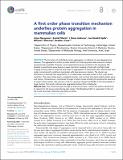A first order phase transition mechanism underlies protein aggregation in mammalian cells
Author(s)
Meriin, Anatoli; Sherman, Michael Y; Narayanan, Arjun; Andrews, James Owen; Spille, Jan Hendrik; Cisse, Ibrahim I; ... Show more Show less
Downloadelife-39695-v1.pdf (2.061Mb)
PUBLISHER_CC
Publisher with Creative Commons License
Creative Commons Attribution
Terms of use
Metadata
Show full item recordAbstract
The formation of misfolded protein aggregates is a hallmark of neurodegenerative diseases. The aggregate formation process exhibits an initial lag phase when precursor clusters spontaneously assemble. However, most experimental assays are blind to this lag phase. We develop a quantitative assay based on super-resolution imaging in fixed cells and light sheet imaging of living cells to study the early steps of aggregation in mammalian cells. We find that even under normal growth conditions mammalian cells have precursor clusters. The cluster size distribution is precisely that expected for a so-called super-saturated system in first order phase transition. This means there exists a nucleation barrier, and a critical size above which clusters grow and mature. Homeostasis is maintained through a Szilard model entailing the preferential clearance of super-critical clusters. We uncover a role for a putative chaperone (RuvBL) in this disassembly of large clusters. The results indicate early aggregates behave like condensates. Editorial note: This article has been through an editorial process in which the authors decide how to respond to the issues raised during peer review. The Reviewing Editor's assessment is that all the issues have been addressed (see decision letter).
Date issued
2019-02Department
Massachusetts Institute of Technology. Center for Materials Science and Engineering; Massachusetts Institute of Technology. Department of PhysicsJournal
eLife
Publisher
eLife Sciences Publications, Ltd
Citation
Narayanan, Arjun et al. “A First Order Phase Transition Mechanism Underlies Protein Aggregation in Mammalian Cells.” eLife 8 (February 2019): e39695 © 2019 The Authors
Version: Final published version
ISSN
2050-084X